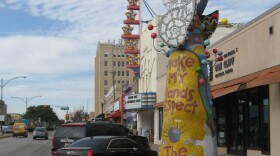In Richardson, high school students are learning about all kinds of health care jobs, from emergency medical technician to nurse’s aide. They’re also getting hands-on experience, but they’re not getting it in a traditional classroom.
High school junior Elea Moore takes visitors on a tour of her new health science classrooms.
“So this is the first classroom and we have the Laerdal, a full-bodied manikin that can simulate abnormal and normal conditions within a person…”
There, resting on a bed, its head propped on a pillow, is a male manikin. He’s the patient. Two students stand at the bed, dressed in teal-colored scrubs with stethoscopes around their necks, just like at a hospital.
In this case, this classroom is in an actual hospital. Methodist Health System donated 7,000 square feet of its campus on W. Campbell Road to the Richardson Independent School District. Students enrolled in the health science program say practicing in a wing of the hospital makes it feel more real.
“Many nursing programs don’t even have this doll because it’s so expensive,” says Saminul Haque, a senior at Richardson High School. “So we were fortunate enough to have this with us and be able to use it and, you know, have in-depth look at how to actually care for patients in health care facility.”

Haque plans to go to medical school and study anesthesiology. He and a classmate stand around the hospital bed examining their manikin patient with the help of a SIMpad. It’s basically a portable touch-screen computer that controls the manikin and records vital information.
“Respiration, heart rate, oxygen … you can change it and adapt it to show how the patient can react to different situation, such as asthma or maybe a mild heart attack, or a heart murmur and what not,” Haque says. “So it’s really cool and interesting.”
Richardson school district officials say this set-up is unique. While other districts have partnerships with hospitals, they say they’ve taken it a step further by turning a hospital into the classroom.
“That allows kids to explore what they really want to do after high school and it’s free because the kids are able to jump from one course to the other,” says Sandra Hayes, assistant superintendent for district operations. “If they find something that they don’t like they don’t have to stay more than that semester or year. But if they find their passion early in high school, then they’re able to put all their energy and resources in that program and just continue to grow.”

More than 220 sophomores, juniors, and seniors are enrolled in the program at the hospital. Another 400 students take entry-level classes at one of the district’s four high schools. Hayes said the district hopes to double its health science program in the coming years.
Bryan Stewart, vice-president for academic affairs at the Tarrant County College River East Campus, oversees health care professions there. He says high schools are doing a better job of exposing students to the health care field and that’s happening as the demand for health care workers grows.
“Five years ago, we were at a point where there were not that many jobs available,” Stewart says. “Over the last five years, you’ve seen the retiring workforce of nurses, you’ve seen Baby Boomers and more folks needing more nursing care, so I think our economy just kind of changed in the last five to seven years.”
Stewart says area hospitals are looking for students who don’t just have medical skills.
...if they find their passion early in high school, then they're able to put all their energy and resources in that program and just continue to grow.
“Our students need to be good at the bed side. They need to be able to communicate. They need to be able to write well,” Stewart says. “You know, all those soft skills are really important.”
Back at the hospital in Richardson, students are learning how to properly turn a patient over in bed. In another area of the wing, students learn how to draw blood using a stuffed dog. Student tour guide Elea Moore says she loves working with people, but she really loves animals, too.
“It’s really cool to come here and learn different careers, so it helps you go down a path and let you know what you want to do when you reach college.”
For Elea, that could mean veterinary school.






